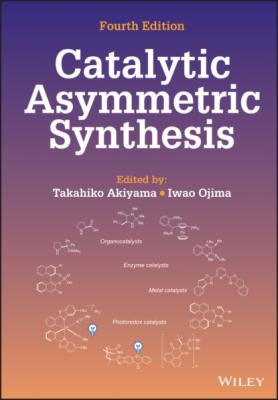Catalytic Asymmetric Synthesis. Группа авторов
Чтение книги онлайн.
Читать онлайн книгу Catalytic Asymmetric Synthesis - Группа авторов страница 50
 9‐anthryl‐2,6‐diisopropylphenyl group at 3,3′‐positions. Iminium ion intermediate 31, which was formed by the condensation of indoline with salicyl aldehyde derivative, was hydrogenated from the 2‐aryl indoline (Scheme 2.68c) [154].
9‐anthryl‐2,6‐diisopropylphenyl group at 3,3′‐positions. Iminium ion intermediate 31, which was formed by the condensation of indoline with salicyl aldehyde derivative, was hydrogenated from the 2‐aryl indoline (Scheme 2.68c) [154].
Scheme 2.68. Transfer hydrogenation using indoline as a hydrogen donor (a) (
Source: Based on [152]
), oxidative kinetic resolution of indolines using ketimine (b) (
Source: Based on [153]
), and oxidative kinetic resolution of indolines based on self‐redox reaction (c) (
Source: Based on [154]).
2.6.2. Reduction of Ketones
Antilla reported an enantioselective reduction of ketones using CPA 6h as the precatalyst. The use of catecholborane as the reducing agent in combination with 4‐dimethylaminopyridine (DMAP) gave secondary alcohols with 82–98% ee (Scheme 2.69). Based on the 11B nuclear magnetic resonance (NMR) study, transition state 32 involving a boro‐phosphate intermediate was proposed [155].
2.6.3. Reduction of Alkenes
Antilla reported a transfer hydrogenation of trans‐chalcone derivatives using CPA 6f, employing borane as the hydride source (Scheme 2.70) [156].
Song developed an efficient method for the reduction of 2‐substituted indoles to produce 2‐substituted indolines by the combined use of CPA 6q and catecholborane in the presence of water. The formation of phosphoric acid boron complex 33 was proposed (Scheme 2.71) [157].
Sun accomplished the reduction of 1,1‐diarylethenes by a transfer hydrogenation that used a combination of Hantzsch ester and CPA 6i to afford 1,1‐diarylethanes with 75–99% ee (Scheme 2.72) [158].
Scheme 2.69. Reduction of ketones by the combined use of catecholborane.
Scheme 2.70. Transfer hydrogenation of chalcone derivatives.
Source: Based on [156].
Scheme 2.71. Reduction of indolines.
Source: Based on [157].
Scheme 2.72. Transfer hydrogenation of 1,1‐diarylethenes.
Source: Based on [158].
2.7. ADDITION TO ALKENES
In order to attain high enantioselectivity, numerous kinds of chiral Brønsted acids were developed. Regarding CPA, bulky 3,3′‐substituents such as 2,4,6‐triisopropylphenyl and 2,4,6‐tricyclohexylphenyl groups were introduced. In order to realize an extremely sterically demanding cavity, List designed and synthesized confined IDP 10a on the basis of a C2‐symmetric imidodiphosphoric acid motif, and realized a highly enantioselective spiroacetalization (Scheme 2.73) [13]. Small and functionally unbiased substrates were found to be suitable because of the geometrically constrained bifunctional active site.
Scheme 2.73. Asymmetric spiroacetalization by confined Brønsted acid.
Source: Based on [13].
Nagorny concurrently reported spiroketalization using CPA 6e, although the use of tertiary alcohols was critical as substrates (Scheme 2.74) [159].
Scheme 2.74. Asymmetric spiroacetalization by TRIP.
Source: Based on [159].
Liu reported an intramolecular hydroamination of alkenes using chiral phosphoramide 34 to furnish pyrrolidines with an α‐tetrasubstituted carbon stereocenter (Scheme 2.75a) [160]. Liu subsequently applied the methodology for the desymmetrization of meso dienes to afford pyrrolidine derivatives bearing two congested tertiary or quaternary stereocenters based on the hydroamination of unactivated alkenes (Scheme 2.75b) [161]. Mechanistic study elucidated the transition state 35, wherein thiourea moiety was employed both as activating and a directing group through cooperative multiple hydrogen bonds with a Brønsted acid and the double bond.
Sun reported an asymmetric synthesis of 1,1‐diarylethanes through a transfer hydrogenation reaction of 1,1‐diarylalkenes bearing o‐hydroxyphenyl moieties and Hantzsch ester using 6i as shown in Scheme 2.72. Indole also participated in the reaction to afford 1,1,1‐triarylethanes bearing acyclic all‐carbon quaternary stereocenters using 13d (Scheme 2.76) [158].









